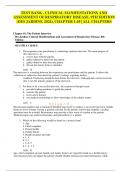Exam (elaborations)
TEST BANK - CLINICAL MANIFESTATIONS AND ASSESSMENT OF RESPIRATORY DISEASE, 9TH EDITION (DES JARDINS, 2024), CHAPTER 1-45 | ALL CHAPTERS
- Course
- Institution
- Book
TEST BANK - CLINICAL MANIFESTATIONS AND ASSESSMENT OF RESPIRATORY DISEASE, 9TH EDITION (DES JARDINS, 2024), CHAPTER 1-45 | ALL CHAPTERS
[Show more]



